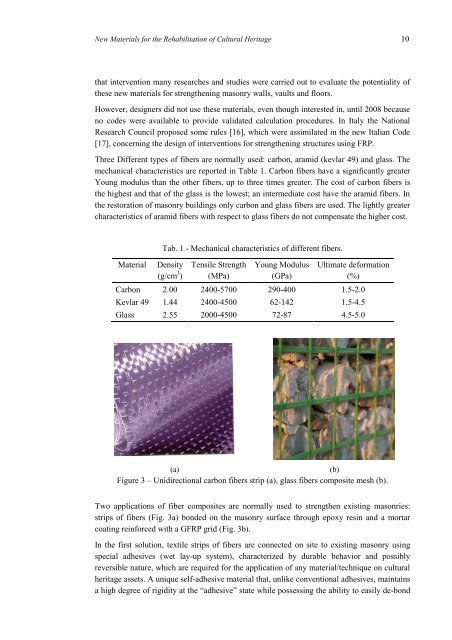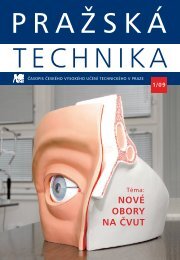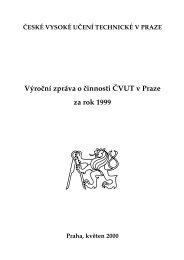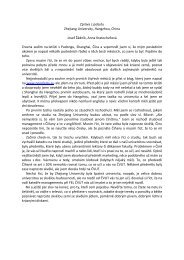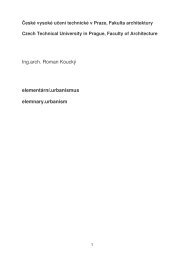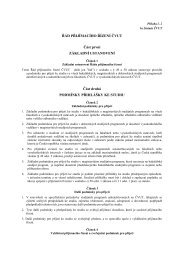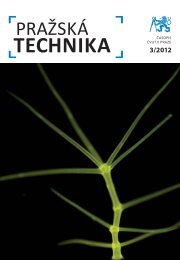New Materials for the Rehabilitation of Cultural Heritage - Czech ...
New Materials for the Rehabilitation of Cultural Heritage - Czech ...
New Materials for the Rehabilitation of Cultural Heritage - Czech ...
You also want an ePaper? Increase the reach of your titles
YUMPU automatically turns print PDFs into web optimized ePapers that Google loves.
<strong>New</strong> <strong>Materials</strong> <strong>for</strong> <strong>the</strong> <strong>Rehabilitation</strong> <strong>of</strong> <strong>Cultural</strong> <strong>Heritage</strong> 10<br />
that intervention many researches and studies were carried out to evaluate <strong>the</strong> potentiality <strong>of</strong><br />
<strong>the</strong>se new materials <strong>for</strong> streng<strong>the</strong>ning masonry walls, vaults and floors.<br />
However, designers did not use <strong>the</strong>se materials, even though interested in, until 2008 because<br />
no codes were available to provide validated calculation procedures. In Italy <strong>the</strong> National<br />
Research Council proposed some rules [16], which were assimilated in <strong>the</strong> new Italian Code<br />
[17], concerning <strong>the</strong> design <strong>of</strong> interventions <strong>for</strong> streng<strong>the</strong>ning structures using FRP.<br />
Three Different types <strong>of</strong> fibers are normally used: carbon, aramid (kevlar 49) and glass. The<br />
mechanical characteristics are reported in Table 1. Carbon fibers have a significantly greater<br />
Young modulus than <strong>the</strong> o<strong>the</strong>r fibers, up to three times greater. The cost <strong>of</strong> carbon fibers is<br />
<strong>the</strong> highest and that <strong>of</strong> <strong>the</strong> glass is <strong>the</strong> lowest; an intermediate cost have <strong>the</strong> aramid fibers. In<br />
<strong>the</strong> restoration <strong>of</strong> masonry buildings only carbon and glass fibers are used. The lightly greater<br />
characteristics <strong>of</strong> aramid fibers with respect to glass fibers do not compensate <strong>the</strong> higher cost.<br />
Material Density<br />
(g/cm 3 )<br />
Tab. 1 - Mechanical characteristics <strong>of</strong> different fibers.<br />
Tensile Strength<br />
(MPa)<br />
Young Modulus<br />
(GPa)<br />
Ultimate de<strong>for</strong>mation<br />
(%)<br />
Carbon 2.00 2400-5700 290-400 1.5-2.0<br />
Kevlar 49 1.44 2400-4500 62-142 1.5-4.5<br />
Glass 2.55 2000-4500 72-87 4.5-5.0<br />
(a) (b)<br />
Figure 3 –Unidirectional carbon fibers strip (a), glass fibers composite mesh (b).<br />
Two applications <strong>of</strong> fiber composites are normally used to streng<strong>the</strong>n existing masonries:<br />
strips <strong>of</strong> fibers (Fig. 3a) bonded on <strong>the</strong> masonry surface through epoxy resin and a mortar<br />
coating rein<strong>for</strong>ced with a GFRP grid (Fig. 3b).<br />
In <strong>the</strong> first solution, textile strips <strong>of</strong> fibers are connected on site to existing masonry using<br />
special adhesives (wet lay-up system), characterized by durable behavior and possibly<br />
reversible nature, which are required <strong>for</strong> <strong>the</strong> application <strong>of</strong> any material/technique on cultural<br />
heritage assets. A unique self-adhesive material that, unlike conventional adhesives, maintains<br />
a high degree <strong>of</strong> rigidity at <strong>the</strong> “adhesive” state while posesing <strong>the</strong> ability to easily de-bond


